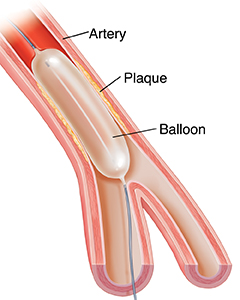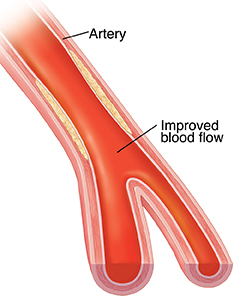Coronary Angioplasty
Your healthcare team will talk to you about your heart problem and explain how angioplasty can help. Angioplasty relieves symptoms of coronary artery disease by improving blood flow to your heart. Chest pain (angina) can be caused by poor blood flow through a narrow or blocked artery that would normally supply oxygen and nutrients to the heart muscle. Not all blockages can be fixed by coronary angioplasty alone. You may need other treatments including medicines, surgery, or coronary stents to treat your coronary artery disease. A heart specialist called an interventional cardiologist does the angioplasty procedure. They have specialized training in using the equipment and in doing the procedure as safely as possible.
 |
| The balloon compresses the plaque against the artery wall. |
 |
| Blood flow to the heart muscle increases. |
Risks of angioplasty
All procedures have risks. Possible risks linked to angioplasty include:
-
Bleeding at the site where the catheter is put into the body (usually the groin, wrist, or arm)
-
Blood clot or damage to the blood vessel from the catheter
-
Blood clot in the treated blood vessel
-
Infection at the catheter insertion site
-
Abnormal heart rhythms
-
Heart attack
-
Stroke
-
Chest pain or discomfort
-
Bursting (rupture) of the coronary artery or complete closing of the coronary artery, needing open-heart surgery
-
Allergic reaction to the contrast dye used
-
Kidney damage from the contrast dye. Tell your healthcare provider if you have kidney disease.
During the procedure
-
A member of the healthcare team will numb the skin at the insertion site (usually the groin, wrist, or arm) with a local anesthetic. This is so you don't feel pain when the catheter is inserted. Next, your healthcare provider will make a small hole or cut (puncture) to insert the catheter.
-
Your provider will insert a guide wire through a thin, flexible tube (the guiding catheter) and move it to the narrow spot in your heart artery. They will use an angiogram to see the blockage. An angiogram is an X-ray movie of blood flow through the heart arteries using contrast dye.
-
Your provider will insert a balloon-tipped catheter through the guiding catheter and thread it over the guide wire. They'll position it at the narrowed part of the artery.
-
Next they'll inflate and deflate the balloon several times to compress the plaque against the artery wall. You may feel pressure or chest discomfort when the balloon is inflated. Tell your provider if you do.
-
Often, a stent is also placed in the artery. This is a small, metal mesh tube that helps prop the sides of the blood vessel open and keeps it from closing again.
-
Finally, your provider deflates the balloon and removes the catheters and guide wire. The artery is now open, and blood flow to the heart muscle is restored.
After the procedure
-
You'll need to stay still in bed. This is to prevent bleeding. The amount of time you must lie still may depend on if a closure device, such as a stitch or collagen plug, was used to close the opening that was made in your artery. The time you must be still may be shorter if one of these devices was used.
-
A nurse will check the insertion site and your blood pressure often (about every 15 to 30 minutes). Before going home, you may have an electrocardiogram or other tests if needed.
-
You may be able to go home after several hours on the same day. Or you may spend the night in the hospital after your procedure. Depending on your condition and the results of your procedure, your stay may be longer.
-
Plan to have someone drive you home.
-
You may be started on new medicines to prevent blood clots from forming at the site in your artery where the angioplasty was done. Make sure you take this medicine as directed. Other medicines that are often prescribed are to prevent re-narrowing of the arteries or to prevent a heart attack. These medicines commonly include:
-
A medicine to lower cholesterol (statin)
-
Medicines to thin your blood to help prevent blood clots (such as aspirin or clopidogrel)
-
Medicine to take to ease chest discomfort (such as nitroglycerin)
-
Your activity will be restricted for about 3 to 7 days while the puncture site (groin, wrist, or arm) is healing.
-
Keep the puncture site clean and dry until the skin heals in the area. Showering is OK. But don't soak in a bathtub, hot tub, or swimming pool until the skin has healed.
-
It's normal to have a bruise or to feel a pea-sized bump under the skin at the puncture site. This bump may be a collagen plug or stitches that were used to close the artery. It should get smaller as time goes by. You should not have active bleeding or a growing bruise at the site.
Call 911
Call 911 if any of the following occur:
-
Abnormal or lasting chest pain
-
Severe pain, numbness, coldness, or a bluish color in the leg or arm where the catheter was inserted
-
Fainting
-
You have blood in your urine; bloody, black, or tarry stools; or any other kind of significant bleeding
When to call your healthcare provider
Call your healthcare provider if you have any of the following:
-
You have chest pain that's quickly eased with medicines
-
The insertion site has pain, swelling, redness, bleeding, or drainage
-
Fever of 100.4°F (38°C) or higher, or as advised by your provider
© 2000-2025 The StayWell Company, LLC. All rights reserved. This information is not intended as a substitute for professional medical care. Always follow your healthcare professional's instructions.